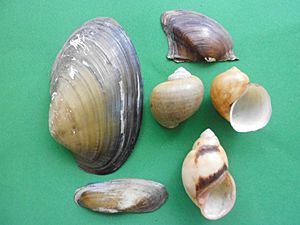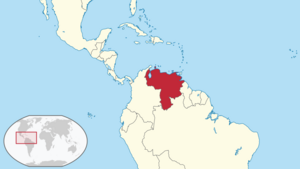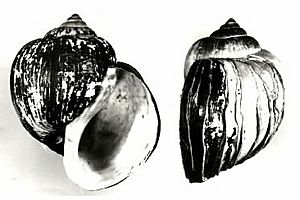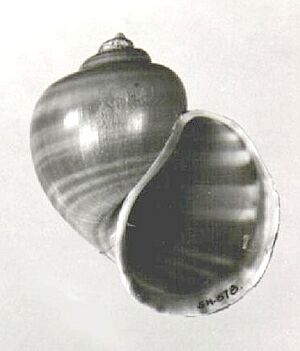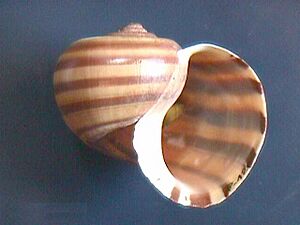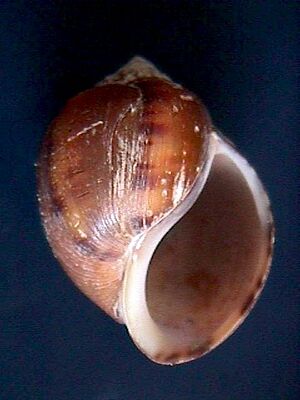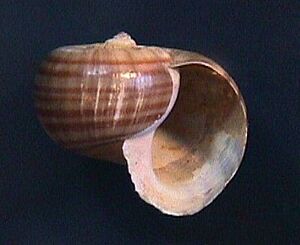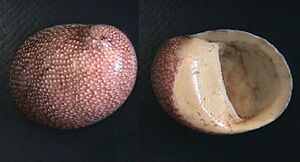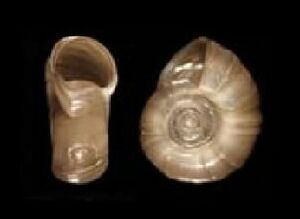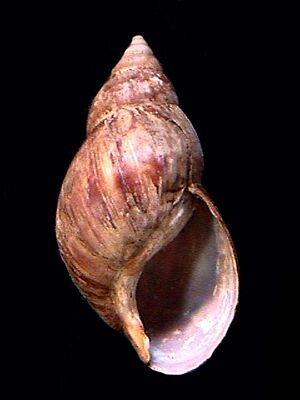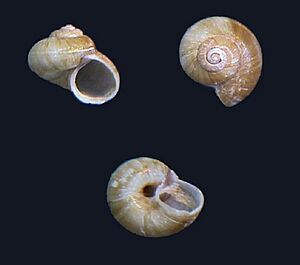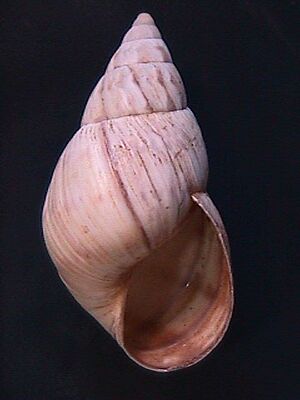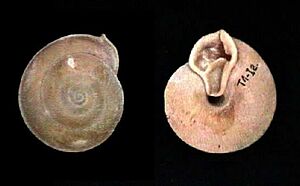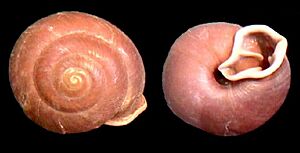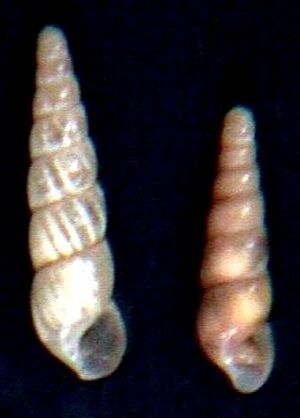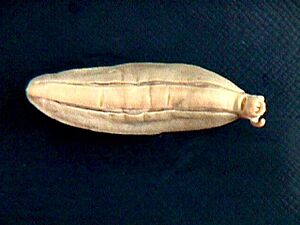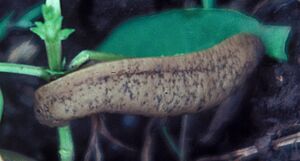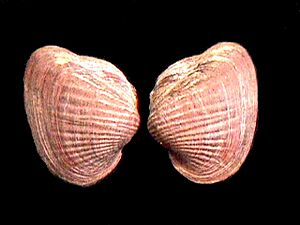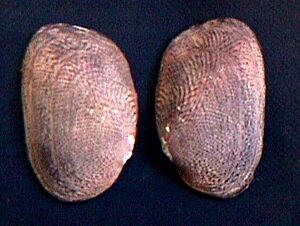List of non-marine molluscs of Venezuela facts for kids
The non-marine molluscs of Venezuela are a group of amazing creatures found in Venezuela. These are snails, clams, and mussels that live in freshwater. They also include snails and slugs that live on land. This list does not include molluscs that live in the sea.
Many different kinds of non-marine molluscs live in the wild across Venezuela.
Contents
Exploring Venezuela's Molluscs: A Look Back in Time
Studies about Venezuela's molluscs began a long time ago. In the 1800s, a German scientist named Eduard von Martens published the first list of molluscs in Venezuela in 1873. Just three years later, another scientist, Adolfo Ernst, added to Martens' list.
After these first studies, new information came out slowly. It took about 50 years for new lists to appear. An American scientist, H. B. Baker, published more findings in the 1920s.
Since Baker's work, many Venezuelan species have been described. Scientists have also created many national and local lists. For example:
- Adolfo Lutz studied molluscs around Valencia lake in 1928.
- H. Richards and others described molluscs on Margarita Island in 1940.
- Arias described animals in the Baruta, El Hatillo, and Perija regions in the 1950s.
- Thompson wrote about molluscs in Henri Pittier National Park in 1957.
- Martinez and Miranda described land snails and slugs in Caracas in 1968.
- Fernández described slugs in Venezuela in 1982.
- Martinez and others listed freshwater clams in 2004.
- Lasso and his team described animals in the Orinoco river basin in 2009.
Amazing Variety: The Diversity of Venezuelan Molluscs
Venezuela's non-marine molluscs belong to two main groups: Gastropoda (snails and slugs) and Bivalvia (clams and mussels). Gastropods have many more species than bivalves.
For freshwater snails, the Ampullariidae family (apple snails) has 35 species. The Planorbidae family has 15 species. For land snails and slugs, the Ortalicidae family has 35 species. The Subulinidae family has 16 species.
Among freshwater clams, the Mycetopodidade family has 17 species. The Hyriidae family has 10 species.
Some mollusc species have been brought to Venezuela from other places. Most of these are land molluscs. The Subulinidae family has 6 introduced species. The Limacidae family has 4, and the Helicidae family has 3.
Where Do Venezuelan Molluscs Live?
Non-marine molluscs are found all over Venezuela. However, the largest number of species lives in the Orinoco river basin. Most species prefer calm waters like rivers, lakes, or flooded areas.
Some species live only in certain places. For example, some slugs are mostly found in farming areas in the north and Andean regions. But other species are found all over the country. This includes amphibian molluscs from the Ampullariidae family. Famous examples are Marisa cornuarietis, Pomacea urceus (also called Guarura), Pomacea glauca, and Pomacea dolioides. A well-known land snail is Megalobulimus oblongus (Guacara).
Some introduced species have spread widely. These include the Achatina fulica (Giant African Snail), Arion subfuscus, Subulina octona, Thiara granifera, and Melanoides tuberculata.
Types of Non-Marine Molluscs in Venezuela
Venezuela's non-marine molluscs include:
- Freshwater gastropods: 9 families, 19 genera, 82 species.
- Land gastropods: 26 families, 58 genera, 116 species.
- Freshwater bivalves: 5 families, 11 genera, 31 species.
In total, there are 30 families, 88 genera, and 229 species listed.
Freshwater Snails (Gastropods)
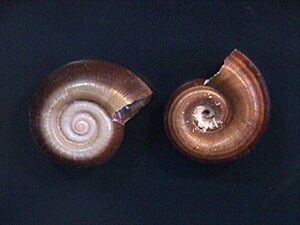
Here are some examples of freshwater snails found in Venezuela:
Ampullariidae (Apple Snails)
- Marisa cornuarietis (Linnaeus, 1758)
- Pomacea bridgesi (Reeve, 1856) (Introduced species)
- Pomacea dolioides (Revee, 1856)
- Pomacea glauca (Linnaeus, 1758)
- Pomacea urceus (Müller, 1774)
Hydrobiidae
- Pyrgophorus coronatus (Pfeiffer, 1840)
- Pyrgophorus parvulus (Guilding, 1828)
Lymnaeidae
- Galba neotropica (Bargues, Artigas, Mera y Sierra, Pointier & Mas-Coma, 2007) - native
- Galba cubensis (Pfeiffer, 1839) - introduced from the Caribbean
- Pseudosuccinea columella (Say, 1817) - introduced from the Caribbean
Neritidae
- Neritina puncticulata (Lamarck, 1816)
- Neritina virginea (Linnaeus 1758)
Pachychilidae
- Pachychilus laevisimus (Sowerby, 1824)
Physidae
- Aplexa rivalis (Manton & Rackett, 1807)
Planorbidae
- Biomphalaria glabrata (Say, 1818)
- Biomphalaria straminea (Dunker, 1848)
- Planorbella duryi (Wetherby 1879) (introduced species)
Thiaridae
- Melanoides tuberculata (Müller, 1774) (introduced species)
- Thiara granifera (Lamarck, 1822) (introduced species)
Land Snails and Slugs (Gastropods)
Here are some examples of land snails and slugs found in Venezuela:
Achatinidae
- Achatina fulica (Bowdich, 1822) (introduced species, also known as the Giant African Snail)
Arionidae
- Arion subfuscus (Draparnaud, 1805) (introduced species)
Bradybaenidae
- Bradybaena similaris (Fèrussac, 1821) (introduced species)
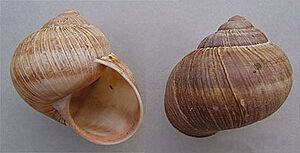
- Cornu aspersum (Müller, 1774) (introduced species)
- Helix pomatia Linnaeus, 1758 (introduced species)
Strophocheilidae
- Megalobulimus oblongus (Müller, 1774) (also known as Guacara)
Neocyclotidae
- Poteria translucida (Sowerby, 1843)
Amphibulimidae
- Dryptus marmoratus (Dunker, 1844)
- Plekocheilus breweri Breure & Schlögl, 2010
Orthalicidae
- Oxystyla maracaibensis (Pfeiffer, 1899)
Bulimulidae
- Drymaeus multilineatus (Say, 1825)
Pleurodontidae
- Labyrinthus plicatus (Born, 1780)
- Labyrinthus umbrus (Thompson, 1957)
Subulinidae
- Allopeas micra (d’Orbigny, 1835) (introduced species)
- Subulina octona (Bruguière, 1798) (introduced species)
Veronicellidae
- Diplosolenodes occidentalis (Guilding, 1825)
- Sarasinula plebeia (Fischer, 1868)
Freshwater Clams (Bivalves)
Here are some examples of freshwater clams found in Venezuela:
Corbiculidae
- Corbicula fluminalis (Múller, 1774) (introduced species)
Hyriidae
- Castalia schombergiana Sowerby, 1869
- Dilodon granosus Bruguiere, 1782
- Paxyodon syrmatophorus Meuschen, 1781
Mycetopodidae
- Anodontites trapesialis Lamarck, 1819
- Mycetopoda pittieri Marshall, 1919
- Tamsiella tamsiana Dunker, 1895
See also
 In Spanish: Moluscos no marinos de Venezuela para niños
In Spanish: Moluscos no marinos de Venezuela para niños
- List of echinoderms of Venezuela
- List of Poriferans of Venezuela
- List of introduced molluscs of Venezuela
- List of marine molluscs of Venezuela
- List of molluscs of Falcón state, Venezuela
- List of non-marine molluscs of El Hatillo Municipality, Miranda, Venezuela
- List of birds of Venezuela
- List of mammals of Venezuela
Lists of molluscs of surrounding countries:
- List of non-marine molluscs of Colombia
- List of non-marine molluscs of Guyana
- List of non-marine molluscs of Brazil
Overseas:
- List of non-marine molluscs of Trinidad and Tobago
- List of non-marine molluscs of Grenada
- List of non-marine molluscs of Curaçao
- List of non-marine molluscs of Aruba


